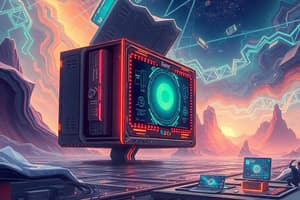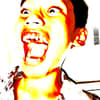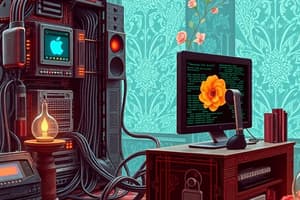Podcast
Questions and Answers
Dè an toradh a tha CamScanner a' toirt seachad dha na luchd-cleachdaidh aige?
Dè an toradh a tha CamScanner a' toirt seachad dha na luchd-cleachdaidh aige?
- A' toirt air falbh miann sònraichte bhon taobh a-staigh.
- Leigeas e le bhith a' scanning dhealbhan agus glèidhteas. (correct)
- Leigeas e le bhith clàradh fìor-ùine.
- A' toirt seachad sheirbheisean rannsachaidh air-loidhne.
Ciamar a gheibh luchd-cleachdaidh a' bhathar-bog CamScanner faidhlichean a leughadh?
Ciamar a gheibh luchd-cleachdaidh a' bhathar-bog CamScanner faidhlichean a leughadh?
- Tro sholair fòn-làimhe. (correct)
- Tro phlanaichean fo bhlàr.
- Tro bhrosnachadh a-steach.
- Tro chomas LED.
Dè am feart a tha a' freagairt air ceanglaichean didseatach CamScanner?
Dè am feart a tha a' freagairt air ceanglaichean didseatach CamScanner?
- A' samhlachadh feartan seòlaidh pàipear.
- A' cur a-mach clò-bhualaidhean ann an dath.
- A' toirt seachad freagairtean nach eil freagairteach.
- A' freagairt ri bhith a’ cruthachadh ceanglaichean PDF. (correct)
Dè na seòrsaichean faidhle a theachdaire CamScanner?
Dè na seòrsaichean faidhle a theachdaire CamScanner?
Dè cho furasta 's a tha e faighinn a-mach a’ bhathar-bog CamScanner?
Dè cho furasta 's a tha e faighinn a-mach a’ bhathar-bog CamScanner?
Flashcards are hidden until you start studying
Study Notes
### Compscoil Skills - Introduction
- A computer accepts input, stores it temporarily in memory, processes it, and then transfers the processed data to an output device.
- Data is raw, unorganized facts.
- Information is processed data, organized to be meaningful.
- Hardware refers to the physical parts of a computer.
- Software are instructions that tell the computer hardware what to do. These are programs.
### Computer Hardware
- Internal hardware is located inside the computer's main box.
- External hardware connects to the computer, often via wired or wireless connections.
- Input devices: Keyboard, mouse, scanner, camera, touchscreen, etc.
- Output devices: Monitor, printer, speakers, projector, etc.
- Processing devices: CPU (Central Processing Unit) performs calculations and controls the computer's operations.
- Storage devices: Hard drives, CDs/DVDs, USB flash drives, etc., used to store data.
- Communication devices: MoDems, network adapters, etc.,allow communication with others online.
Computer Software
- Software tells the computer what and how to perform tasks.
- System software: Main software that starts up and controls the computer's operations.(Examples include operating systems like Windows, Linux.)
- Utility programs: Analyze, configure, optimize, and maintain the computer.
- Application software is used for specific tasks (Examples include word processors, web browsers, multimedia programs.)
- The System Unit is the main housing for the computer's processing hardware, including memory, power supply, cooling fans, and storage devices.
The Motherboard
- The motherboard is the main circuit board.
- It contains computer chips (silicon pieces), circuits (connections), and other electronic components.
- All computer components must connect to the motherboard.
Primary Components of a Computer
- Input devices: Accept data from the user and prepare it for processing.
- Output devices: Provide results to the user in a human-readable format(e.g., text, graphics).
The CPU
- CPU (Central Processing Unit) is the "brain" of the computer.
- Contains electronic circuits that perform processing tasks.
- Interprets, processes, and executes instructions.
- Includes different cores for parallel processing to improve speed. (e.g., dual-core, quad-core CPUs)
Memory (RAM)
- RAM (Random Access Memory) is temporary storage.
- Used to hold data and instructions requiring immediate access.
- Volatile: Data loss when power is off.
- Range: 256MB to 16GB.
Memory (ROM)
- ROM (Read-Only Memory) is non-volatile storage.
- Stores essential instructions that operate when the computer starts.
Secondary Storage Devices
- Secondary storage devices are for permanent storage of data.
- Magnetic storage: Hard drives, floppy disks.
- Optical storage: CDs, DVDs.
Memory Hierarchy
- Registers are inside the CPU.
- Cache memory is faster than main memory but smaller.
- Main memory is relatively fast and stores data needed soon.
- Mass storage (hard drive) is large and permanent, but slower.
- Cost vs capacity: Cost increases as capacity increases. Faster memory tends to be more expensive.
Basic Units of Measurement
- Bit (Binary digit): 0 or 1.
- Byte: 8 bits.
- Kilobyte (KB), megabyte (MB), Gigabyte (GB), Terabyte (TB), etc.. represent increasing capacities.
Buses (Structure of a Microcomputer)
- Buses are electronic paths for data transfer between parts of a computer.
- Types of buses include: Address bus, data bus, and control bus.
Ports and Connectors
- Ports are connections on the outside of a computer system for devices.
How the CPU Works
- Consists of many transistors and circuits.
- A key element of modern CPUs is the transistor.
- The number of transistors in a CPU doubles roughly every 18 months.
- Typical CPU components: ALU, FPU, CU, Prefetcher, Decoder, Internal Cache, and Registers.
Operating Systems
- A collection of programs that manage the coordinated activities of a computer system.
- Functions: Interfacing with the user, managing resources, booting the system, configuring devices, file management.
Computer Languages
- Low-level languages (e.g., machine code, assembly): Close to how the hardware operates.
- High-level languages (e.g., Fortran, Pascal, C++, Java): Closer to natural language, making them easier for humans to use.
- Assembly: Symbolic representation of machine code, more efficient.
- High-level language: Consisting of English-like keywords. (e.g., Print, IF-THEN-ELSE).
High-level Language (structured)
- Structured design: Dividing a problem into smaller subproblems.
- Structured programming: Implementing a structured design.
- Stepwise refinement: Designing a system in modules.
High-level Language (OOP)
- Object-oriented programming (OOP): Identifying components (objects), combining data and operations into a single unit, specifying relevant data.
Studying That Suits You
Use AI to generate personalized quizzes and flashcards to suit your learning preferences.




